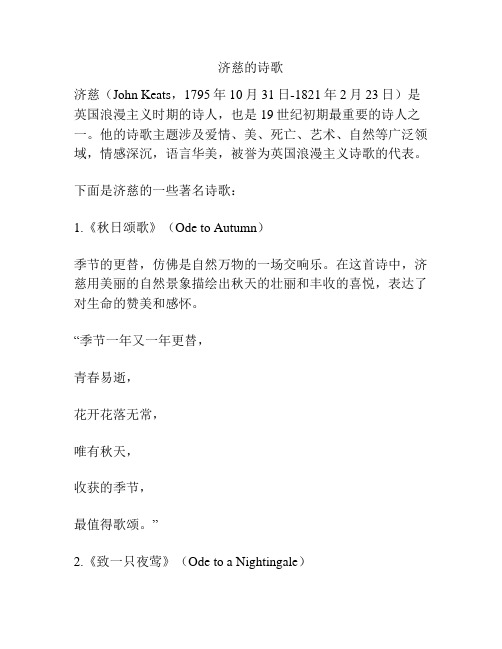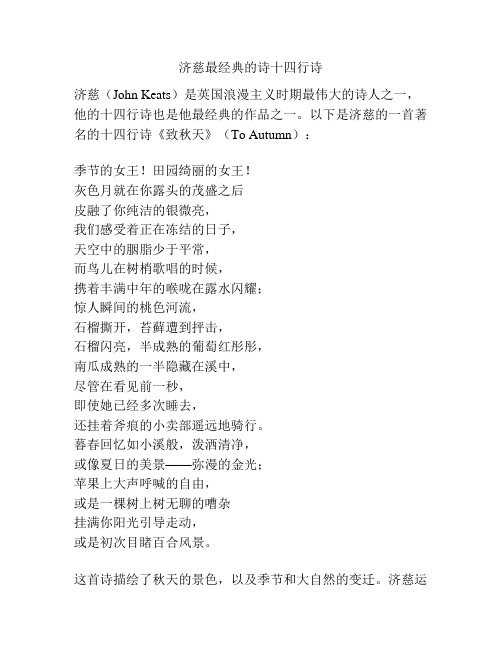这是英国浪漫主义诗人济慈
济慈简介

济慈简介JohnKeats(1795~1821)英国诗人。
1795年10月29日生于伦敦。
他的父亲以经营马车行为业,生活比较富裕。
1804年父亲去世,母亲再嫁,济慈和两个弟弟由外祖母收养。
1810年母亲又病故,外祖母委托两名保护人经管他们弟兄的财产。
1811年,济慈由保护人安排离开学校,充当医生的学徒。
他对医学并不厌弃,但也喜好文学,并在中学的好友查尔斯·克拉克的鼓励之下开始写诗,模仿伊丽莎白时代诗人埃德蒙·斯宾塞。
1815年10月,济慈进入伦敦一家医院学习。
这时他已热爱写诗,深受诗人亨特和华兹华斯的影响。
1816年5月在亨特所编《检察者》杂志发表十四行诗《孤寂》。
1816年7月,通过考试获得内科医生执照,继续学习外科。
同年夏写成十四行诗《初读查普曼译荷马史诗》。
10月间经克拉克介绍,与亨特相识,并与雪莱、哈兹里特、兰姆等人来往。
11月间,济慈决心从事文学创作,通知他的保护人,放弃学医。
1817年,济慈出版第一部诗集,其中大多带有模仿的痕迹,但也有佳作,如上述的读荷马史诗的十四行诗和《蟋蟀与蚱蜢》等,而《睡眠与诗》则表露了济慈的创作思想,即诗应给人们以安慰,并提高他们的思想。
诗集出版后得到好评。
4月,济慈写作长诗《恩底弥翁》,以凡人恩底弥翁和月亮女神的恋爱故事为题材,虽嫌松散,但已显出他对周围世界中的美的境界的敏感和独特的语言表达能力。
与此同时,济慈也形成了许多对哲学和艺术的观点,其中著名的有“天然接受力”的思想。
根据济慈的解释,在一个大诗人身上,对美的感受能压倒或抵消一切其他的考虑,如莎士比亚就突出地具有这种能力。
1817年冬,济慈在伦敦与华兹华斯相见。
虽然他仍然钦佩华兹华斯的诗,却不喜欢他的为人。
和亨特也渐渐疏远。
1818年3月,济慈去外地照顾患病的弟弟托姆。
这时他写成取材于薄伽丘的《十日谈》的叙事诗《伊萨贝拉》。
他的思想发生了很大的变化,从强调感官享受转而强调思想深度。
约翰·济慈致芬妮·勃劳恩之情书

约翰·济慈致芬妮·勃劳恩之情书这是英国浪漫主义诗人济慈(1795-1821)写给恋人芬妮·勃劳恩的情书。
1818年,23岁的济慈认识并爱上了邻家少女勃劳恩,并在伦敦订婚。
后来,他因看护弟弟而传染了肺结核病。
1820年,他在友人的陪伴下去意大利休养,但还是于1821年2月23日在罗马去世。
此信写于济慈去世前不久,表达了他对恋人的爱,以及对两人关系的担忧。
WednesdayMorning.recoverifIamtobesolongseparatefromyou;yetw ithallthis3)devotiontoyou,Icannotpersuademyselfintoany4)con fidenceofyou.Youareso5)desirabletome-theairIbreatheinaroomemptyofyouisunhealthy.Iamnotthesametoy ou-no-youcanwait-youhaveathousand6)activities-youcanbehappywithoutme.Anyparty,anythingtofillupthedayhasbe enenough.Howhaveyoupassedthismonth-Whohaveyousmiledwith-Allthismayseem7)savageinme.YoudonofeelasIdo-youdonotknowwhatitistolove-onedayyoumay-yourtimeisnotcome.I8)appealtoyou:Donotwritetomeifyouhavedoneanythingthismonth whichitwouldhavepainedme.Youmayhavechanged-ifyouhavenot-ifyoustill9)behaveindancingroomsandotherssocietiesasIhavese enyou-Idonotwanttolive-ifyouhavedoneso,Iwishthiscomingnightmaybemylast.Icannotlivewithoutyou,andnotonlyyoubut10)chasteyou;11)virtuousyou.TheSunrisesandsets,thedaypasses,andyoudowhateveryoul ike-youdon"tknowthe12)miserablefeelingthatpassesthroughmeinaday -Beserious!Loveisnotaplaything-andagaindonotwriteunlessyoucandoitwithacrystal13)conscience .Iwouldsoonerdiefor14)wantofyouthan-YoursforeverJ.Keats亲爱的女孩:今天早晨我去了散步,随手带着一本书。
济慈的诗歌

济慈的诗歌引言济慈(John Keats)是英国浪漫主义诗人中最富盛名的一位。
他以其独特的诗歌风格和对美的追求而闻名于世。
济慈的诗歌作品充满了对自然、爱情、美和死亡等主题的深刻探索,具有强烈的情感表达和精致的诗意。
本文将全面、详细地探讨济慈的诗歌作品,旨在帮助读者更好地理解和欣赏这位伟大诗人的艺术成就。
济慈的生平简介济慈于1795年出生于伦敦一个中产阶级家庭,早年失去了父母,由其监护人抚养长大。
他在学校学习医学,但对诗歌的热爱促使他抛弃了医学事业,专注于写作。
他的第一本诗集《原头脑草地》于1817年出版,但并未获得较大成功。
然而,他的第二本诗集《超度也是快乐的》(1818年)以及《夏天的女神》(1819年)让他成为当时备受欢迎的诗人。
济慈的诗歌创作风格1. 浪漫主义情感表达济慈的诗歌充满了浪漫主义的情感表达,他深情地抒发了对自然、爱情、艺术和死亡的深刻感受。
例如,在他的诗歌《秋日边缘》中,他用美丽的词句描绘了秋天的景色,表达了对短暂美好的感伤和对时间流逝的思考。
2. 精致的诗意和鲜明的意象济慈的诗歌充满了丰富的诗意和鲜明的意象,他通过巧妙的比喻和形象化的语言,将抽象的概念变得具体而形象。
例如,在他的诗歌《吟游诗人》中,他用诗意的语言描绘了诗人的创作过程和内心体验,营造出一种纯粹的诗歌氛围。
3. 对自然的热爱和追求济慈对自然的热爱和追求是他诗歌创作的重要主题之一。
他通过对大自然景色的描绘,表达了对自然美的赞美和对与自然融为一体的渴望。
在他的诗歌《杜鹃》中,他用丰富的形象和感性的语言展示了杜鹃鸟的美丽和自由。
济慈的代表作品分析1. 《超度也是快乐的》《超度也是快乐的》是济慈最重要的诗集之一,其中包括了许多著名的诗篇。
其中最著名的是《恒河之歌》,这篇诗描绘了一个古代传说中的故事,以及对生命和灵魂永恒性的思考。
此外,《洞窟的神圣叙事》和《聚会证言》等诗篇也展示了他对生命和人类经验的深入思考。
2. 《夏天的女神》《夏天的女神》是济慈最后的诗歌集,也是他最富有成就的作品之一。
济慈的诗歌

济慈的诗歌济慈(John Keats,1795年10月31日-1821年2月23日)是英国浪漫主义时期的诗人,也是19世纪初期最重要的诗人之一。
他的诗歌主题涉及爱情、美、死亡、艺术、自然等广泛领域,情感深沉,语言华美,被誉为英国浪漫主义诗歌的代表。
下面是济慈的一些著名诗歌:1.《秋日颂歌》(Ode to Autumn)季节的更替,仿佛是自然万物的一场交响乐。
在这首诗中,济慈用美丽的自然景象描绘出秋天的壮丽和丰收的喜悦,表达了对生命的赞美和感怀。
“季节一年又一年更替,青春易逝,花开花落无常,唯有秋天,收获的季节,最值得歌颂。
”2.《致一只夜莺》(Ode to a Nightingale)这首诗歌是济慈最著名的作品之一,它通过夜莺的歌声,表达了对美和永恒的追求,同时也探讨了人类存在的无常和有限性。
“离开世俗的束缚,我要沉浸在你的歌声中,和你一起飞翔,直达美和永恒的彼岸。
”3.《美女肖像》(The Eve of St. Agnes)这是一首长篇叙事诗,描绘了一个古老的传说,讲述了一个年轻的男人热切追求他梦想中的女孩。
诗歌以浪漫主义的方式描绘了爱情和美的永恒追求。
"她——美如天仙,飘逸如矫健的鹤鸣;她——悠然自在,安静如法国列车的轻盈声音;她——尤为美丽,就像一束烈火,散发着天使般的光芒。
"4.《没人欣赏槲寄生的美》(No One so Much as You)这首短篇诗歌向爱情献上了赞美。
济慈用槲寄生作为象征,表达了人们在追求美和爱情时所经历的困难和挫折。
最后,他呼吁对方在彼此的爱情中寻找安宁和幸福。
“我多少次战胜了痛苦,才得到你的爱,而你的美,却久经考验,在冬季里颤栗,在春天里任由风儿吹拂,可没有人欣赏它的存在。
”5.《翻译是译不出来的》(On First Looking into Chapman’s Homer)这首诗是济慈的一首短诗,它描述了济慈第一次读到莎士比亚的诗歌的感受。
济慈最经典的诗十四行诗

济慈最经典的诗十四行诗
济慈(John Keats)是英国浪漫主义时期最伟大的诗人之一,他的十四行诗也是他最经典的作品之一。
以下是济慈的一首著名的十四行诗《致秋天》(To Autumn):
季节的女王!田园绮丽的女王!
灰色月就在你露头的茂盛之后
皮融了你纯洁的银微亮,
我们感受着正在冻结的日子,
天空中的胭脂少于平常,
而鸟儿在树梢歌唱的时候,
携着丰满中年的喉咙在露水闪耀;
惊人瞬间的桃色河流,
石榴撕开,苔藓遭到抨击,
石榴闪亮,半成熟的葡萄红彤彤,
南瓜成熟的一半隐藏在溪中,
尽管在看见前一秒,
即使她已经多次睡去,
还挂着斧痕的小卖部遥远地骑行。
暮春回忆如小溪般,泼洒清净,
或像夏日的美景——弥漫的金光;
苹果上大声呼喊的自由,
或是一棵树上树无聊的嘈杂
挂满你阳光引导走动,
或是初次目睹百合风景。
这首诗描绘了秋天的景色,以及季节和大自然的变迁。
济慈运
用了丰富的形象和细腻的描写,展示了秋天的美丽和丰收的景象。
这首诗以其优美的形式和深刻的感受,被认为是济慈最优秀的作品之一。
诗人济慈的诗歌介绍

诗人济慈的诗歌介绍济慈是英国浪漫主义诗人中的代表人物,被誉为“英国诗歌的神童”。
他的诗歌多采用自然题材,充满激情和美感。
以下是济慈的几首代表诗歌(中文+英文):1、《秋日田园》季节转换,一切都在变化。
日夜不止,光阴如梭。
秋日的芜菁在田野里茁壮成长,丝绸状的玉米、金黄色的小麦,灵芝、蘑菇在枯草丛中生长,松鼠挥舞着尾巴狂奔,芦花舞动在水塘里,一切都充满着生命的活力。
2、《樱桃之歌》樱桃在阳光下蹦跳着,穿过田野,穿过林间,那光彩照人的笑容,是如此的纯粹和美好。
她本是一个普通的女孩,但在这春光明媚的季节里,她变了一个样,她用她的美丽和活力,点亮了整个世界的色彩。
3、《诗人的叹息》人生的旅途如同一场漫长的旅行,我们在途中哭过、笑过、感到幸福、悲伤。
时间会嫌我们年轻、会让我们老去,但我们要学会把握现在,用诗歌记录下每一个瞬间的美好,在心中埋下一颗丰盈的种子,让它在岁月的沉淀中变得越来越美好。
4、《当时光消逝时》当时光消逝时,寂静无声,如醉如梦。
一切都在变化,风吹过,绿叶纷飞,阳光照耀下,花儿娇艳欲滴。
我们的青春也在流逝,岁月不停驻足,让我们珍惜每一刻,用诗歌记录下它们的美好。
5、《飞舞的蝴蝶》飞舞的蝴蝶,快乐而自由,它们在花丛间翩翩起舞,身披五彩斑斓的羽翼,如同流动着滚烫的绒花。
纷飞的花瓣,似天堂的精灵,一只只蝴蝶,翩翩起舞,舞动翅膀,翩翩起舞,它们的美丽,是大自然的礼物。
6、《溪流慢歌》溪流快乐地流淌着,清新的水滴远去,流动的水面上,掀起层层涟漪,慢悠悠地流淌着,漫不经心地流淌着,似乎在讲述自然的妙处。
我们在这里静静地等待,在流水潺潺的声音中,静静感受生命的意义。
7、《不能弥补的损失》时间是肆无忌惮的流失,无法弥补我们已经失去的,如同在黑夜中寻找曙光,留下的却是无尽的悲伤。
友情并非那么容易得到,缘份也并不是无限的延续,过往的事情时常在脑海中翻腾,深深地打动着心扉。
8、《草地上的阳光》草地上的阳光把一切都照耀得那么美好,在这片草地中,人们欢笑、嬉戏,小鸟在天空中飞翔着,欢唱着生命的美妙。
济慈诗歌全译

济慈诗歌全译济慈(John Keats)是英国浪漫主义时期最杰出的诗人之一,他的诗歌以其深情、细腻和富有想象力而闻名于世。
他的诗作中融入了对自然、美和人生哲理的追求,展现了他对艺术和人类情感的独特理解。
本文将以“济慈诗歌全译”为中心,展开对济慈诗歌的全面解读和翻译。
济慈的诗歌作品涉及广泛的主题,包括对自然景观的赞美、对爱情的表达、对艺术的思考等。
其中,他最著名的作品之一是《秋颂》(Ode to Autumn),这首诗以饱满细腻的词语描绘了秋天的景色和气息,表达了对季节变迁和自然律的赞美。
以下是对《秋颂》的全译:季节之神,你丰饶而温暖,被灰蓝色云彩所衬托。
你的发丝像金色的玉米。
你的面颊如苹果的红润。
你的伴侣是草原和果实,他们跟随你的脚步,把温暖的阳光洒向大地。
琥珀色的麦田静静摇曳,金色的果实垂挂在树枝上。
葡萄酒榨汁的声音回响,蜂蝶忙碌在鲜花之间。
红色的蜜蜂嗡嗡作响,收割者的歌声乐此不疲。
你是繁荣的季节,你把丰收的喜悦带给人们。
你的阳光如黄金一般温暖,你的微风轻拂着脸庞。
你是大地的恩赐,你是生命的源泉。
《秋颂》展现了济慈对秋天的独特感悟,他通过细腻的描写和丰富的意象,描绘出秋天的丰饶和生机。
在他的笔下,秋天不再是凋谢和死亡的象征,而是一季丰收和生命的盛宴。
除了《秋颂》,济慈还有许多其他优秀的诗作。
他的诗集《夜想集》(Nocturnes)中包含了一系列对夜晚景色的描写,表达了他对夜晚的独特情感和思考。
以下是对《夜想集》中的一首诗的全译:月光洒在静谧的大地上,星星点缀着黑色的天空。
夜晚如黑色的绸缎般沉静,它抚平了白天的纷扰。
夜的湖泊闪烁着银色的光,树林中的影子在风中摇曳。
夜莺在枝头高声歌唱,它们的歌声如水晶般清澈。
我独自站在这片黑暗中,感受着宇宙的神秘魅力。
我沉浸在夜晚的静谧中,让思绪在黑暗中自由飞翔。
济慈的诗歌充满了对自然、美和人生的思考和感悟,他用细腻的笔触和丰富的意象,展现了他对世界的敏感和独特的艺术眼光。
to autumn济慈赏析

to autumn济慈赏析《to autumn》是济慈的一首诗歌作品,描绘了秋天的美丽景色和丰收的季节。
本文将从济慈的生平背景、诗歌的主题和意象、以及诗歌的结构和语言运用等方面对《to autumn》进行赏析。
了解济慈的生平背景对于理解《to autumn》这首诗的意义非常重要。
约翰·济慈(John Keats)是英国著名的浪漫主义诗人,生于1795年,逝世于1821年。
济慈的一生充满了悲剧和苦难,但他通过诗歌表达了对生命的热爱和对自然的赞美。
《to autumn》是他在生命的最后一年创作的作品之一,也是他最著名的作品之一。
《to autumn》以描绘秋天的景色和丰收的季节为主题,通过生动的意象和细腻的描写,表达了济慈对自然的热爱和对生命的追求。
诗中的“秋天”被赋予了人的形象,具有丰富的感官形象和情感内涵。
济慈运用了大量的比喻和隐喻,使诗歌更具有表现力和感染力。
诗歌的开篇,济慈用“季节的女神”来比喻秋天,把秋天描绘成一位美丽、温暖而慈祥的女神,给人一种和谐、安宁的感觉。
在之后的描述中,济慈通过丰富的意象描绘了秋天的景色和丰收的季节。
他用“果实饱满的葡萄”、“丰收的苹果”等生动的描写,展现了大自然的丰富和生机。
同时,济慈还运用了音乐的比喻,用“小溪的歌声”和“悠扬的响声”来形容秋天的声音,使诗歌更具有韵律感和音乐性。
诗歌的结构和语言运用也是济慈的创作特点之一。
《to autumn》由三个十四行诗组成,每个十四行诗的行数和押韵方式都是相同的。
这种结构上的对称性使诗歌更加整齐和统一。
济慈的语言运用非常富有诗意,他运用了大量的修辞手法,如比喻、隐喻、拟人等,使诗歌更加生动和富有表现力。
《to autumn》是济慈一首充满生命力和热情的诗歌作品,通过对秋天的描绘和对自然的赞美,表达了济慈对生命和自然的热爱。
诗歌的主题和意象丰富多样,语言运用优美流畅,给人以美的享受和思考的空间。
济慈通过这首诗歌,展示了他作为浪漫主义诗人的独特魅力和才华,也留下了一部不朽的文学作品。
- 1、下载文档前请自行甄别文档内容的完整性,平台不提供额外的编辑、内容补充、找答案等附加服务。
- 2、"仅部分预览"的文档,不可在线预览部分如存在完整性等问题,可反馈申请退款(可完整预览的文档不适用该条件!)。
- 3、如文档侵犯您的权益,请联系客服反馈,我们会尽快为您处理(人工客服工作时间:9:00-18:30)。
英国浪漫主义诗人济慈简介(汉英对照)这是英国浪漫主义诗人济慈(1795-1821)写给恋人芬妮·勃劳恩的情书。
1818年,23岁的济慈认识并爱上了邻家少女勃劳恩,并在伦敦订婚。
后来,他因看护弟弟而传染了肺结核病。
1820年,他在友人的陪伴下去意大利休养,但还是于1821年2月23日在罗马去世。
此信写于济慈去世前不久,表达了他对恋人的爱,以及对两人关系的担忧。
”1818年的秋天,弗朗西丝·林顿的名字还是芬妮·布劳恩,在汉普斯蒂德她遇见了名叫约翰·济慈的诗人。
这位默默无闻的林顿夫人,正是现在举世闻名的济慈未曾提起过的情人。
直到去世7年后,芬妮的身份才为人所知。
尽管她曾把她和济慈的爱情故事讲给她的孩子们听,也向他们展示过济慈写给她的书信,但同时她也要他们保证不将此事告诉他们的父亲。
然而当1872年路易斯·林顿逝世后,她的孩子们(主要是赫伯特)便将母亲的故事换为大笔收益。
他们确实大赚了一笔。
虽然济慈死于1821年,年仅25岁,当时并不出名,但其后几年人们逐渐认识到了他的才华。
现在他被认为是英国最伟大的诗人。
他的诗作十分畅销,1848年,首部济慈传记出版发行,由理查德·蒙克顿·米尔斯和济慈的几位朋友写成,然而其内容也激怒了不少人。
比如珀西·雪莱在挽歌《阿多尼斯》中指出,米尔斯的传记把济慈描绘成了一个被攻击性评论害死的病弱梦想家,这个形象过于感伤同时也犯了精神上的错误。
虽然传记中有提到济慈与一个年轻小姐订婚,但未论及她的姓名。
芬妮见证了济慈的名声渐起,或许她也读了不少赞颂济慈的书籍。
但她从没道出过自己身份,也没有对济慈的生活表现出很大兴趣。
他的丈夫只知道她作为那位诗人的邻居在汉普斯蒂德见过面。
然而她一直把济慈写给她的情书留在身边,整整有三打;其中许多是短笺,其余则是长篇累牍的示爱,还有一些是出于嫉妒的胡言乱语,流露出济慈不为人知的一面。
济慈和芬妮相遇时,这位诗人正处在他人生中最混乱的时期。
他最小的弟弟汤姆身患严重的肺结核,这种疾病夺去过他母亲的生命,如今也掌握着汤姆和济慈的。
不过最初横亘在他与芬妮间的并不是疾病,而是贫困。
1818年秋,济慈刚与好友查尔斯·布朗从苏格兰游历归来。
布朗之前把他那幢被称为维特沃茨的拼连住宅租了一半给布劳恩一家,他回来时,布劳恩家暂时搬去了榆木村。
在住在维特沃茨的那段时间里,他们和邻居戴尔克(他们也是济慈的朋友)成为了要好朋友。
戴尔克家人经常聊起济慈,并对他称赞不已。
因此早在布劳恩一家见到受人尊敬的年轻济慈本人前,就已经喜欢上了他。
布劳恩夫人是一位带着三个孩子的寡妇——18岁的芬妮,14岁的儿子山姆和9岁的女儿玛格丽特。
正值青春年少的芬妮相貌并不出众,但性格活泼为人亲切。
大概是自小家庭穷困的缘故,芬妮是个绝对的现实主义和实用主义者。
她非常注意穿衣打扮,对年轻追求者的奉承也总是乐在其中。
汉普斯蒂德离贵族军营很近,全年都有数场军营舞会,芬妮就是其中受欢迎的参加者。
济慈第一眼看到芬妮时便被她迷人的好玩天性所深深吸引,“自从得知你惊恐地发觉自己倾心于克里希得,我是多么痛苦啊。
”在一次乔叟(此乔叟非彼乔叟)对芬妮无耻的逗弄后,济慈这样对芬妮说。
后来芬妮回忆道,他们初次相见于戴尔克家,那天济慈精神不错,谈话也极为有趣,除了说到他弟弟的健康问题时大家都黯然神伤起来。
诚然,无论年轻的布劳恩小姐给济慈留下了怎样的印象,当时的他正为弟弟的病情烦恼而没有对芬妮留心太多。
直到11月底之前,济慈都是把他醒着的每一分钟花在陪伴病危的汤姆上的。
那间位于威尔沃克的小小房间,一度是济慈兄弟相依为命的地方,现在则萦绕着沮丧,绝望和悲痛之情。
当汤姆最终死于12月1日,济慈感到了疲惫与麻木。
汤姆那可怕的,无法除去的病状深深烙印于济慈的记忆之中。
然而至少芬妮·布劳恩分散了他的痛苦。
为了远远离开威尔沃克这块伤心地,济慈欣然接受布朗要他搬到维特沃茨的邀请。
这并不完全是布朗的好心施舍,济慈支付了一定数额住宿费用。
因为隔壁就住着戴尔克,济慈串门也就愈加频繁。
而每次棕发碧眼的芬妮总是给他留下更深刻的印象。
济慈常常对芬妮即不解又恼火,这也是她吸引他的因素之一,济慈完全不能理解芬妮。
12月中旬,也就是汤姆去世两周后,他给远在美国的乔治和乔治安娜写了封长信,“夏天租下布朗房子的布劳恩夫人至今还住在维特沃茨。
她是个好人,我觉得她的长女芬妮漂亮,优美,高雅,愚笨,时髦又古怪。
我们时不时的就要吵架——现在她可规矩多了,否则我见到她就跑。
”偶尔济慈也会把芬妮从脑海中驱逐出去。
在他二月中给乔治的信中只是随便提到几句(他和芬妮闲聊了又吵嘴了)。
他再度对诗歌充满激情。
不过芬妮和诗成为他生活的两大中心只是个或早或晚的问题。
我们无从知道芬妮的文学倾向是什么,倒是一次济慈作了如下评论,“我真的认为我遇见的这位女士会在小说的护送下嫁给诗歌”虽然她阅读并称赞他的作品,她本人从未参与过诗歌创作。
1819年的整个冬季,济慈都在汉普斯蒂德伏案写作。
1月份他完成了《圣艾妮丝节前夜》,一个月后,《圣马可节前夜》也大功告成,在春季到来前,他一直在写他的野心之作《海伯利安》,并故意没有把它写完。
1819年3月3日,济慈不得不住得离那位恼人的布劳恩小姐更近。
因为戴尔克一家决定搬往市中心于是把他们原本的屋子转租给了布劳恩夫人和他的孩子们。
现在芬妮成了济慈的隔壁邻居,她的魅力渐渐使他沉醉其中。
从4月开始,恋情在两个人间萌发了。
济慈中断了严肃题材诗歌的写作,转而为芬妮写起十四行诗,其中就包括著名诗歌《灿烂的星》。
大部分诗都在详述芬妮的身形之美但也赞美了有芬妮相伴时的欢愉与放纵。
不可避免的,初恋的经历消耗了他的生命,换回的是新的动力,新的灵感和对自身情感世界的新的洞察。
他的诗歌由此开始焕发出新生的成熟与力量。
4月末,他开始写他最受人欢迎的作品之一,《无情的妖女》。
诗歌讲述了一位妖女诱惑骑士走向灭亡的故事,全诗感情饱满,辞藻优美,论述恰如其分。
不过其中并没有佳作连篇的迹象,济慈本人也觉得这不过是灵光一现,在一封寄给乔治的信里,他开玩笑地对此诗不屑一顾。
接着,在几周的时间里,济慈创作出了他一生中所写的最美的诗歌——《希腊古瓮颂》,《夜莺颂》和《忧郁颂》。
这些诗作保持了济慈一贯的天才般的表达,无愧于他伟大诗人的称号。
然而他的早期成就没有获得世人认可,没有称赞,甚至都没有立即出版。
取而代之的是更长时间的写作,以及忙里偷闲地和芬妮、布朗共度美好时光。
布劳恩夫人这才意识到济慈与芬妮间恋情所带来的一系列严重的问题;她对此非常不满。
济慈是个聪明和善的年轻人,但他穷苦,所选的职业也没什么成功的希望。
而她的善良天性又使她不忍拆散这一对佳人。
她渐渐喜欢上了这位诗人,后来济慈病倒后也是由她一直照料。
倒是布朗对这段关系持反对态度。
他讨厌芬妮,有可能是出于对芬妮占去济慈大量时间和思考的嫉妒。
也有可能他了解济慈用情之深而芬妮又是如此轻佻。
他反对济慈向她求婚,济慈所有的朋友(除了戴尔克)都对芬妮抱有蔑视之情。
他们注意到她的戏弄行径使济慈既绝望又嫉妒,每天为这个分心,还让他怎么写出好诗呢?对于此事,济慈并非没有觉察到朋友们的良苦用心,而是清楚地了解自己不可能被扰乱心神。
自他向布劳恩表白爱意已有两年,他喜欢这种感觉,正是它给他的诗歌增添了些许力量。
他继续写作,于6月初完成《怠惰颂》。
题目取自马太福音第六章28节,耶稣劝说他的追随者不要过于激进:“何必为衣裳忧虑呢?你想野地里的百合花怎么长起来;他也不劳苦,也不纺线。
”3月中一封寄给乔治和乔治安娜的信中他提到了写这首诗的灵感:“今天早上我觉得有点懒散和无忧无虑……诗歌,野心,爱情毫无预警地来到我的身旁:他们看起来更像是古希腊花瓶上的三尊人像——一个男人和两个女人——唯有我才能认出他们。
这是一种纯粹的快乐;一个为数不多的肉体超越意志的例子。
”随后《赛吉颂》完成。
到夏日终于到来之时,济慈已经写下了一连串的佳作。
然而金钱上的紧张问题仍然不容忘怀,这迫使他到怀特岛的尚克林度夏。
假期的便宜旅舍可以省下不少钱,同时也让这位诗人得以不受干扰地继续写作。
那时他正在写《拉弥亚》的第一部分和《奥托大帝》,布朗鼓励济慈写这部戏剧,作为他们剧本创作事业的起点。
他们希望写剧本会比诗歌更赚钱。
《拉弥亚》则是一部优美的作品,其中毫不掩饰地表达了济慈对伍德豪斯的评价:“女人喜欢被迫做一些事,被一个好伴侣所迫。
”这首诗写实地将爱情描述为一种猛烈且具有破坏性的力量。
在此之后济慈与芬妮书信往来极为频繁,《拉弥亚》显露出这个诗人正沉浸在爱情的复杂感受之中。
8月,济慈离开怀特岛来到温切斯特。
在那儿他写了《拉弥亚》的第二部分以及美丽的《秋颂》。
10月他回到汉普斯泰德和芬妮正式订婚。
久别3个月后的重逢让济慈喜不自禁;“你令我目眩”,他给芬妮这样写道。
她依然嘲弄济慈,举止轻佻使他嫉妒吃醋。
诗人在爱情和诗歌间忙得不可开交。
当济慈见到芬妮,帮助写诗的假期中的宁静便立刻烟消云散了。
婚姻是他们唯一的选择。
即将到来的婚姻使济慈重新考量经济上的危机。
他不得不靠写作赚钱;即便数目极小。
他在11月见了他的出版商拟定为一些诗出书的计划。
他还向泰勒借了些十六世纪历史著作来研究莱斯特伯爵。
早些时候布朗向他提出的写剧本赚钱也让他。
现在他想着要写出一部关于伊丽莎白一世真爱的戏剧,选择这个莎士比亚所在的时代可能是他故意为之。
他可以由人物的感情而不是从他们的举止创造出伟大的戏剧。
现在他准备成为和他的偶像一样的剧作家,以多年写诗的经验作为基础,为前方的真正成功做准备。
他写给泰勒说他希望尽快完成大作,“若上帝赦罪于我”。
1月,他的弟弟乔治从美国回来向济慈借了更多的钱,祖母的地产,济慈把大部分给了乔治兄弟两的距离又加深一层。
虽然比济慈年轻,乔治已经结婚并拥有自己的一番事业,而济慈甚至无钱迎娶芬妮。
“乔治不应该这么做,”谈及借款时济慈这么对芬妮说,“他还不如叫我孤寡一辈子——对布朗说这件事时他更为刻薄:”布朗,他应该这么问我,你,约翰,有这么多朋友,他们一定会好好照顾你的。
”但是济慈也很清楚自己能够和芬妮结婚的唯一希望是他文学工作上的成功。
而1820年2月,他们的未来被远比贫穷更凶险的事情威胁了。
那个月一开始就很糟,似乎预示着厄运的到来。
布朗的女佣告诉他济慈正饮用鸦片酊。
面对布朗,济慈发誓把它戒除。
布朗相信济慈只是拿它来提神,但事实是他把它当做普通的镇痛药。
偶尔困扰着他的喉痛和咳嗽如一场感冒病愈般的消失了,取而代之的却是胸闷。
2月3日,济慈经历了第一次肺出血Sonnet 18 One of the best known of Shakespeare’s sonnets, Sonnet 18 is memorable for the skillful and varied presentation of subject matter, in which the poet’s feelings reach a level of rapture unseen in the previous sonnets. The poet here abandons his quest for the youth to have a child, and instead glories in the youth’s beauty. Initially, the poet poses a question—”Shall I compare thee to a summer’s day?”—and then reflects on it, remarking that the youth’s beauty far surpasses summer’s delights. The imagery is the very essence of simplicity: “wind” and “buds.” In the fourth line, legal terminology—”summer’s lease”—is introduced in contrast to the commonplace images in the first three lines. Note also the poet’s use of extremes in the phrases “more lovely,” “all too short,” and “too hot”; these phrases emphasize the young man’s beauty. Although lines 9 through 12 are marked by a more expansive tone and deeper feeling, the poet returns to the simplicity of the opening images. As one expects in Shakespeare’s sonnets, the proposition that the poet sets up in the first eight lines—that all nature is subject to imperfection—is now contrasted in these next four lines beginning with “But.” Although beauty naturally declines at some point—”And every fair from fair sometime declines”—the youth’s beauty will not; his unchanging appearance is atypical of nature’s steady progression. Even death is impotent against the youth’s beauty. Note the ambiguity in the phrase “eternal lines”: Are these “lines” the poet’s verses or the youth’s hop ed-for children? Or are they simply wrinkles meant to represent the process of aging? Whatever the answer, the poet is jubilant in this sonnet because nothing threatens the young man’s beautiful appearance. Then follows the concluding couplet: “So long as men can breathe, or eyes can see, / So long lives this, and this gives life to thee.” The poet is describing not what the youth is but what he will be ages hence, as captured in the poet’s eternal verse—or again, in a hoped-for child. Whatever one may feel about the sentiment expressed in the sonnet and especially in these last two lines, one cannot help but notice an abrupt change in the poet’s own estimate of his poetic writing. Following the poet’s disparaging reference to his “pupil pen” and “barren rhyme” in Sonnet 16, it comes as a surprise in Sonnet 18 to find him boasting that his poetry will be eternal. __________________________________________________________________ 2.Sonnet 18 Summary The speaker opens the poem with a question addressed to the beloved: "Shall I compare thee to a summer's day?" The next eleven lines are devoted to such a comparison. In line 2, the speaker stipulates what mainly differentiates the young man from the summer's day: he is "more lovely and more temperate." Summer's days tend toward extremes: they are shaken by "rough winds"; in them, the sun ("the eye of heaven") often shines "too hot," or too dim. And summer is fleeting: its date is too short, and it leads to the withering of autumn, as "every fair from fair sometime declines." The final quatrain of the sonnet tells how the beloved differs from the summer in that respect: his beauty will last forever ("Thy eternal summer shall not fade...") and never die. In the couplet, the speaker explains how the beloved's beauty will accomplish this feat, and not perish because it is preserved in the poem, which will last forever; it will live "as long as men can breathe or eyes can see." Commentary This sonnet is certainly the most famous in the sequence of Shakespeare's sonnets; it may be the most famous lyric poem in English. AmongShakespeare's works, only lines such as "To be or not to be" and "Romeo, Romeo, wherefore art thou Romeo?" are better-known. This is not to say that it is at all the best or most interesting or most beautiful of the sonnets; but the simplicity and loveliness of its praise of the beloved has guaranteed its place. On the surface, the poem is simply a statement of praise about the beauty of the beloved; summer tends to unpleasant extremes of windiness and heat, but the beloved is always mild and temperate. Summer is incidentally personified as the "eye of heaven" with its "gold complexion"; the imagery throughout is simple and unaffected, with the "darling buds of May" giving way to the "eternal summer", which the speaker promises the beloved. The language, too, is comparatively unadorned for the sonnets; it is not heavy with alliteration or assonance, and nearly every line is its own self-contained clause--almost every line ends with some punctuation, which effects a pause. Sonnet 18 is the first poem in the sonnets not to explicitly encourage the young man to have children. The "procreation" sequence of the first 17 sonnets ended with the speaker's realization that the young man might not need children to preserve his beauty; he could also live, the speaker writes at the end of Sonnet 17, "in my rhyme." Sonnet 18, then, is the first "rhyme"--the speaker's first attempt to preserve the young man's beauty for all time. An important theme of the sonnet (as it is an important theme throughout much of the sequence) is the power of the speaker's poem to defy time and last forever, carrying the beauty of the beloved down to future generations. The beloved's "eternal summer" shall not fade precisely because it is embodied in the sonnet: "So long as men can breathe or eyes can see," the speaker writes in the couplet, "So long lives this, and this gives life to thee."。
